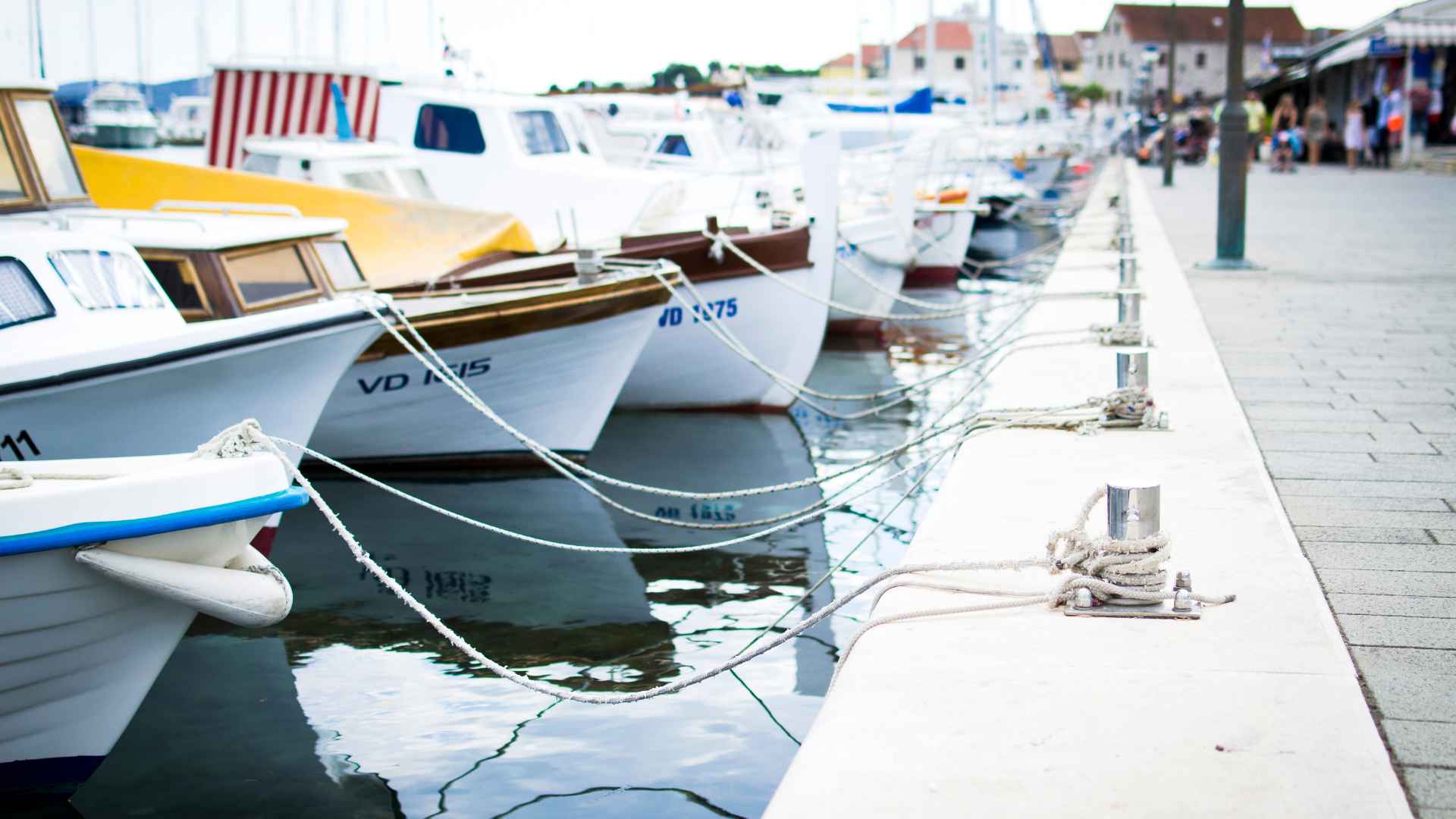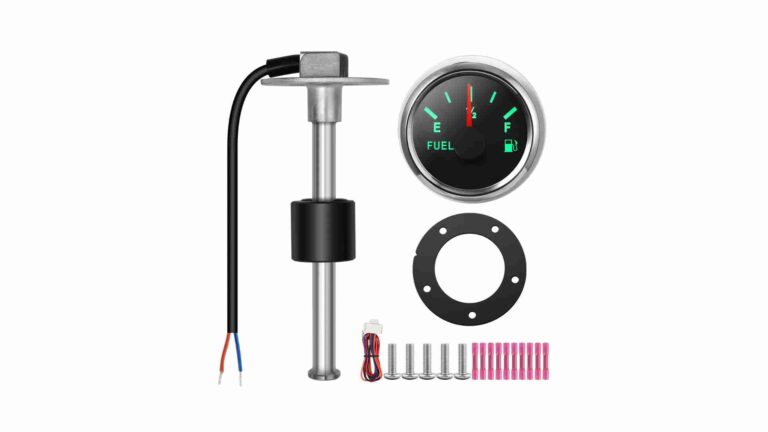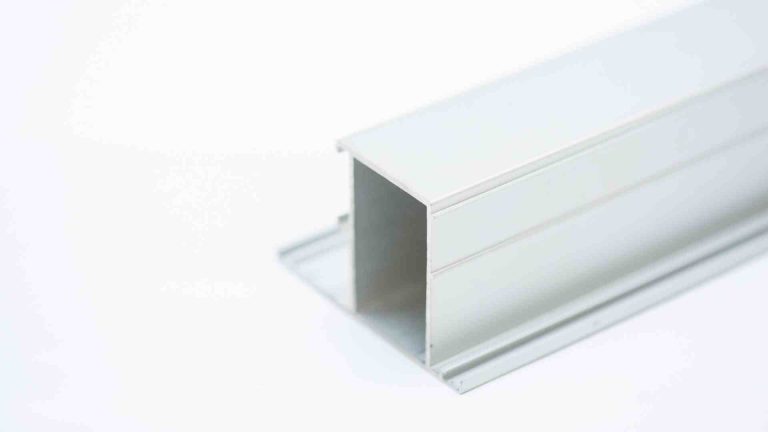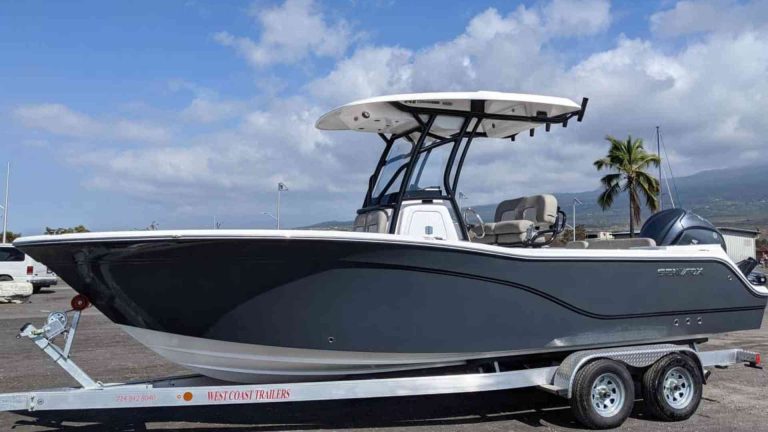What Safety Equipment is Required on a Boat?
Boating offers unparalleled freedom on the water, but safety is paramount to ensure every trip is enjoyable and secure. Whether you’re navigating a serene lake or coastal waters, equipping your vessel with the right safety gear is not just a legal requirement but a lifesaving necessity. This comprehensive guide details the mandatory and recommended safety equipment for boats, their specifications, approximate prices, and practical tips to ensure compliance and safety. Tailored for boaters in the U.S., particularly referencing Virginia regulations, this article also highlights the importance of preparation and education for safe boating.
Why Boat Safety Equipment Matters
Boating accidents can occur due to equipment failure, human error, or environmental challenges. According to the U.S. Coast Guard (USCG), over 80% of boating fatalities involve drowning, often because individuals were not wearing life jackets. Fires, collisions, and mechanical issues also pose significant risks. Carrying the right safety equipment mitigates these dangers, ensuring you and your passengers are prepared for emergencies. Legal requirements vary by state, boat size, and type, so always check local regulations, such as those enforced by the Alabama Law Enforcement Agency or Virginia Department of Wildlife Resources (DWR).
This guide covers the 13 essential safety items required on most boats, additional recommended gear, and best practices to maintain compliance and safety. Specifications and approximate prices are included to help you make informed purchasing decisions.
Mandatory Safety Equipment for Boats
The USCG and state authorities mandate specific safety equipment based on boat size, type, and operating conditions. Below is a detailed breakdown of the required items, their purpose, specifications, and approximate costs.
1. Wearable Life Jackets (Personal Flotation Devices – PFDs)
Purpose: Life jackets are the cornerstone of boating safety, designed to keep individuals afloat during emergencies like capsizing or falling overboard. They are critical for preventing drowning, the leading cause of boating fatalities.
Legal Requirement: Every boat, including paddlecraft (canoes, kayaks, stand-up paddleboards), must carry one USCG-approved wearable life jacket per person, including children and infants. Life jackets must be:
- Properly sized for each passenger.
- In good, serviceable condition (no rips, tears, or waterlogged material).
- Readily accessible (not in locked storage or packaging).
- Worn by children under 13 on federal waters unless below deck or in an enclosed cabin.
Types and Specifications:
- Type I: Offshore life jackets, best for open waters, high buoyancy (22 lbs for adults), turns unconscious wearers face-up. Price: $40–$100.
- Type II: Near-shore vests, less bulky, for calm waters. Buoyancy: 15.5 lbs. Price: $20–$50.
- Type III: Flotation aids for recreational boating, comfortable for continuous wear. Buoyancy: 15.5 lbs. Price: $25–$60.
- Type V: Special-use devices (e.g., inflatable PFDs), approved for specific activities. Must be worn to count as compliant. Price: $50–$150.
Inflatable PFDs: Lightweight, approved for ages 16+, require a full inflation cartridge and functional status indicator. Price: $80–$200.
Tips:
- Test fit before each trip: Ensure the jacket is snug, doesn’t ride up over the chin or ears in water, and allows head movement.
- For children, use jackets with crotch straps to prevent slipping. Lift by shoulders; it should not move more than 3 inches.
- Example: Onyx MoveVent Dynamic Paddle Sports Life Jacket, Type III, fits adults 90+ lbs, adjustable straps. Price: $50.
Chart: Life Jacket Compliance Workflow
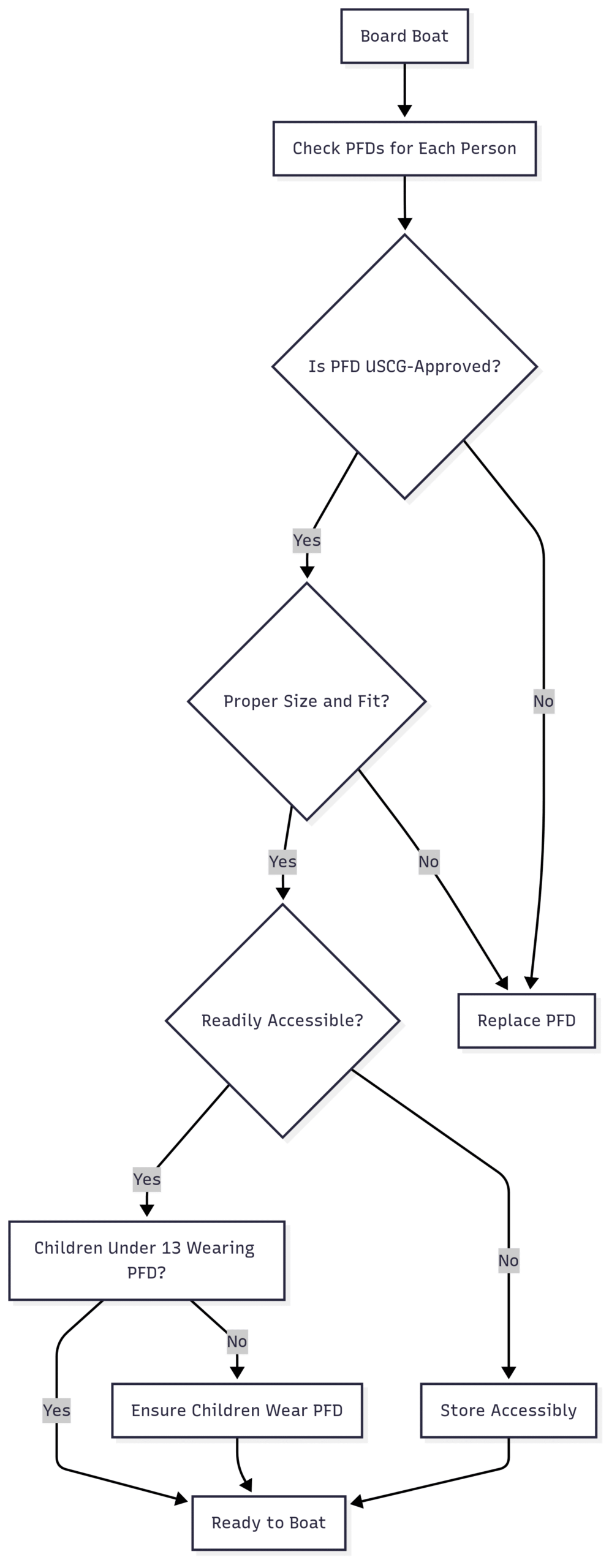
2. Throwable Flotation Devices (Type IV)
Purpose: Designed to assist someone already in the water, throwable devices like ring buoys or cushions provide immediate flotation until rescue.
Legal Requirement: Boats 16 feet or longer (except PWCs) must carry at least one USCG-approved Type IV device, immediately available (not in storage or covered).
Specifications:
- Ring Buoy: 18–24 inches, 16.5 lbs buoyancy, durable vinyl. Price: $20–$40.
- Cushion: Square, 15.5 lbs buoyancy, grab straps. Price: $15–$30.
- Example: Jim-Buoy 18-inch Ring Buoy, UV-resistant, reflective tape. Price: $25.
Tips:
- Store in an open, easily reachable location.
- Train passengers on its location and use.
- Check for wear, ensuring straps and fabric are intact.
3. Fire Extinguishers
Purpose: Fires on boats, often fuel-related, can escalate rapidly. USCG-approved fire extinguishers allow quick response to control or extinguish flames.
Legal Requirement:
- Boats under 26 feet with permanently installed fuel tanks, closed compartments, or living spaces require at least one Type 5-B extinguisher.
- Boats 26–40 feet need two 5-B or one 20-B.
- Boats 40–65 feet need three 5-B or one 20-B plus one 5-B.
- Fixed systems count as one 5-B.
- Extinguishers must be USCG-approved, charged, and not expired (12 years from manufacture).
Specifications:
- Type 5-B: For flammable liquids, 2 lbs agent, 6–10 ft range. Price: $15–$30.
- Type 20-B: 10 lbs agent, 15–20 ft range. Price: $40–$80.
- Example: Kidde Mariner 5-B:C, 2 lbs dry chemical, marine bracket. Price: $20.
Table: Fire Extinguisher Requirements
| Boat Length | No Fixed System | With Fixed System |
|---|---|---|
| Under 16 ft | 1 5-B (if applicable) | 0 |
| 16–26 ft | 1 5-B | 0 |
| 26–40 ft | 2 5-B or 1 20-B | 1 5-B |
| 40–65 ft | 3 5-B or 1 20-B + 1 5-B | 2 5-B |
Tips:
- Mount in accessible locations near engine/fuel areas.
- Check pressure gauges monthly; replace if expired.
- Train crew on operation.
4. Sound-Producing Devices
Purpose: Signals other vessels in low visibility (fog, night) or emergencies to prevent collisions or request assistance.
Legal Requirement: All vessels, including paddlecraft, must carry a device capable of a 4-second blast audible for ½ nautical mile (e.g., whistle, horn, bell).
Specifications:
- Whistle: 120 dB, plastic, lanyard included. Price: $5–$15.
- Air Horn: 115–120 dB, 1.4 oz canister. Price: $10–$25.
- Bell: For boats over 65.6 ft, bronze, 8-inch diameter. Price: $30–$50.
- Example: Fox 40 Classic Whistle, 115 dB, pea-less design. Price: $8.
Tips:
- Test regularly to ensure functionality.
- Attach to life jackets for paddlecraft.
- Store in a dry, accessible location.
5. Visual Distress Signals (VDS)
Purpose: Alert others to emergencies, especially in remote areas, using flares, flags, or lights.
Legal Requirement:
- Boats 16 feet or longer on coastal waters (rivers over 2 miles wide at mouth) need VDS.
- Day: 3 day signals (e.g., orange smoke, flags).
- Night: 3 night signals (e.g., red flares, electric distress light).
- Combination day/night signals (3 total) acceptable.
- Non-pyrotechnic options: Orange distress flag (day), electric distress light (night).
- Smaller boats (<16 ft, open sailboats <26 ft, manually propelled) need night VDS only if operating at night on coastal waters.
Specifications:
- Hand-Held Red Flare: Burns 3 minutes, 500 candela, USCG-approved. Price: $15–$30 for 3.
- Orange Smoke: 1-minute duration, daytime use. Price: $20–$40 for 3.
- Orange Distress Flag: 3×3 ft, black square and ball. Price: $10–$20.
- Electric Distress Light: SOS pattern, 6-hour runtime. Price: $25–$50.
- Example: Orion Coastal Alert/Locate Flare Kit, 3 flares, 1 flag. Price: $50.
Tips:
- Store in waterproof containers.
- Check expiration dates (typically 3–4 years).
- Practice deployment in non-emergency settings.
6. Navigation Lights
Purpose: Ensure visibility and indicate vessel position/movement during low visibility (night, fog).
Legal Requirement: Required for all boats underway between sunset and sunrise or in restricted visibility. Configurations vary:
- Vessels <39.4 ft: Sidelights (red/green, 112.5°), white masthead/all-round light (360° for smaller boats), 1 meter above sidelights.
- Vessels 39.4–65.6 ft: Same as above, stricter placement.
- Unpowered Vessels <23 ft: Optional lights; if none, carry a white-light torch/lantern.
Specifications:
- LED Navigation Light Set: Red/green sidelights (1-mile visibility), white all-round (2-mile visibility). Price: $30–$100.
- Example: Attwood LED Nav Lights, battery-powered, submersible. Price: $40.
Tips:
- Check bulbs/batteries before each trip.
- Understand light patterns for your vessel type.
- Carry spares for bulb replacements.
7. Boat Registration and Decals
Purpose: Proves legal operation and identification of the vessel.
Legal Requirement: All motorized boats and non-motorized boats over a certain length (varies by state) must be registered with the state, displaying a certificate of number and validation decals.
Specifications:
- Certificate: Issued by state DMV or DWR, includes vessel details.
- Decals: Annual stickers, placed per state guidelines (e.g., 3 inches from hull numbers).
- Price: Varies by state ($20–$100 annually).
Tips:
- Keep certificate onboard in a waterproof folder.
- Ensure decals are visible and current.
- Example: Virginia registration, 3-year renewal, ~$30 for boats under 16 ft.
Additional Essential Safety Equipment
While not always legally required, these items enhance safety and are highly recommended.
8. Emergency Radio or Communication Devices
Purpose: Facilitates emergency communication with the Coast Guard or nearby vessels, especially offshore where cell service is unreliable.
Specifications:
- VHF Marine Radio: 25W, 16 emergency channels, waterproof (IPX7). Price: $100–$300.
- Example: Uniden UM385, fixed-mount, DSC capability. Price: $120.
- Handheld VHF: 6W, floating, 10-hour battery. Price: $80–$150.
- Example: Standard Horizon HX210, 6W, floating. Price: $100.
Tips:
- Program Channel 16 (emergency) and monitor.
- Test monthly; ensure battery is charged.
- Carry a backup cell phone in a waterproof case.
9. First Aid Kit
Purpose: Treats minor injuries (cuts, burns) until professional help is available.
Specifications:
- Includes bandages, antiseptic, pain relievers, CPR mask, splints.
- Waterproof container, marine-grade.
- Example: Adventure Medical Kits Marine 100, 50+ items, watertight. Price: $40.
Tips:
- Check for expired items biannually.
- Customize for passenger needs (e.g., medications).
- Store in an accessible, dry location.
10. Throwable Flotation Devices (Repeated for Clarity)
Covered under mandatory equipment but reiterated due to importance. Ensure immediate accessibility.
11. Anchor and Line
Purpose: Prevents drifting in engine failure or strong currents, keeping the boat safe from hazards.
Specifications:
- Fluke Anchor: For sand/mud, 8–13 lbs for small boats. Price: $20–$50.
- Rode: 3/8-inch nylon, 100–200 ft. Price: $30–$60.
- Example: Lewmar 8-lb Fluke Anchor, 150 ft rode. Price: $70.
Tips:
- Choose anchor type based on seabed (e.g., fluke for sand, plow for rocky).
- Ensure adequate rode length (7:1 scope for anchoring).
- Store securely but accessible.
12. Bilge Pump or Manual Bailer
Purpose: Removes water from the hull to prevent sinking during leaks or heavy rain.
Specifications:
- Electric Bilge Pump: 500 GPH, 12V, automatic. Price: $30–$80.
- Manual Bailer: 1-gallon capacity, durable plastic. Price: $10–$20.
- Example: Rule 500 GPH Automatic Bilge Pump. Price: $50.
Tips:
- Test pump before each trip.
- Carry a manual bailer as backup.
- Clear debris from pump intake.
13. Charts, Compass, and GPS
Purpose: Ensures safe navigation, especially in unfamiliar waters or if electronics fail.
Specifications:
- Nautical Chart: NOAA-approved, waterproof. Price: $20–$40.
- Compass: Magnetic, marine-grade, illuminated. Price: $30–$100.
- GPS: Handheld, waterproof, 12-hour battery. Price: $100–$300.
- Example: Garmin GPSMAP 78, marine handheld. Price: $150.
Tips:
- Carry paper charts as backup.
- Calibrate compass annually.
- Update GPS maps regularly.
14. Carbon Monoxide Detector
Purpose: Detects odorless, deadly gas in enclosed cabins from engine exhaust.
Specifications:
- Battery-powered, marine-grade, 5-year lifespan.
- Example: Fireboy-Xintex CMD-6-M, 12V, audible alarm. Price: $100.
Tips:
- Install in sleeping areas.
- Test monthly; replace batteries yearly.
15. Tool Kit and Spare Parts
Purpose: Addresses minor mechanical issues to prevent being stranded.
Specifications:
- Includes screwdrivers, wrenches, pliers, duct tape, fuses.
- Waterproof case, marine-grade tools.
- Example: West Marine 100-Piece Tool Kit. Price: $50.
Tips:
- Tailor to boat’s systems (e.g., engine-specific fuses).
- Store in a dry, accessible box.
- Check inventory before trips.
Boating Safety Education
Purpose: Equips operators with knowledge to handle emergencies and comply with regulations.
Legal Requirement: Many states, including Virginia, require a boating safety certificate for operators of motorized vessels or PWCs (e.g., ages 14–50 in Virginia). Courses cover equipment, navigation rules, and emergency procedures.
Options:
- BOATERexam Online Course: USCG-approved, self-paced, $30–$50.
- State-Specific Courses: Offered by DWR or local providers, often free or $10–$20.
Tips:
- Complete before operating.
- Keep certificate onboard.
- Refresh knowledge every few years.
Summary of Virginia Boating Equipment Requirements
| Equipment | Manually-Propelled | PWCs | <16 ft | 16–26 ft | 26–40 ft | 40–65 ft |
|---|---|---|---|---|---|---|
| Wearable Life Jackets | Required | Required¹ | Required | Required | Required | Required |
| Throwable Device | – | – | – | Required | Required | Required |
| Certificate of Number | – | Required² | Required² | Required² | Required | Required |
| Validation Decals | – | Required² | Required² | Required² | Required | Required |
| Fire Extinguisher (5-B) | – | Required³ | Required³ | Required³ | – | – |
| Fire Extinguisher (20-B) | – | – | – | – | Required⁴ | Required⁵ |
| Engine Cut-Off Switch | – | Required | Required⁹ | Required⁹ | – | – |
| Backfire Flame Arrestor | – | Required | Required | Required | Required | Required |
| Ventilation System | – | Required | Required | Required | Required | Required |
| Muffler | – | Required | Required | Required | Required | Required |
| Sound Device | Required⁸ | Required | Required | Required | Required | Required |
| Daytime VDS (Coastal) | – | – | – | Required | Required | Required |
| Nighttime VDS (Coastal) | Required | – | Required | Required | Required | Required |
| Navigation Lights | Required⁶ | – | Required⁶ | Required⁶ | Required⁶ | Required⁶ |
| Safety Certificate | – | Required⁷ | Required⁷ | Required⁷ | Required⁷ | Required⁷ |
¹ PWC operators/riders must wear PFDs; inflatables prohibited.
² Except non-motorized vessels.
³ For boats with enclosed fuel/combustible spaces.
⁴ One 20-B or two 5-B; fixed system equals one 5-B.
⁵ One 20-B + one 5-B or three 5-B; fixed system equals one 5-B.
⁶ See navigation light configurations.
⁷ For PWCs and motorboats ≥10 hp.
⁸ Capable of 4-second blast, audible ½ nautical mile.
⁹ Required above displacement speed if equipped or post-January 2020 manufacture.
Additional Regulations and Tips
Marine Sanitation Devices (MSDs)
- Vessels with toilets must have USCG-approved MSDs to prevent sewage discharge.
- No-discharge zones (e.g., Smith Mountain Lake) require pump-out at approved facilities.
- Example: Thetford Porta Potti, portable, 5.5-gallon capacity. Price: $100.
Pump-Out Stations
- Contact Virginia Department of Health for locations (804-864-7473).
- Ensure waste is disposed of at approved facilities.
Engine Cut-Off Switch (ECOS)
- Mandatory for boats <26 ft above displacement speed if equipped or manufactured post-January 2020.
- Example: Fell Marine MOB+ Wireless ECOS, clip-on, auto-shutoff. Price: $150.
Backfire Flame Arrestor
- Required for gasoline-powered inboard engines.
- Example: Sierra Flame Arrestor, USCG-approved, fits most carburetors. Price: $50.
Ventilation System
- Gasoline-powered boats with enclosed engine/fuel spaces need two ducts (intake/exhaust) or powered blowers.
- Run blower 4 minutes before starting engine to clear vapors.
Muffling Device
- Exhaust must be muffled via waterline or mechanical baffles.
- Example: Centek Vernatone Muffler, fiberglass, reduces noise. Price: $200.
Best Practices for Safety Equipment Management
- Pre-Trip Inspections:
- Check all equipment for condition and functionality.
- Verify PFDs fit, extinguishers are charged, and VDS are unexpired.
- Test radios, lights, and pumps.
- Storage and Accessibility:
- Store PFDs and throwables in open, reachable areas.
- Keep extinguishers and VDS in waterproof, accessible containers.
- Secure anchors and tools to prevent movement.
- Crew Training:
- Educate passengers on equipment locations and use.
- Practice emergency procedures, like deploying flares or using radios.
- Regular Maintenance:
- Replace expired items (flares, extinguishers, batteries).
- Clean and lubricate tools and pumps.
- Update charts and GPS data.
- Compliance Checks:
- Review state and USCG regulations annually.
- Carry proof of registration and safety certificate.
- Be aware of no-discharge zones and coastal VDS rules.
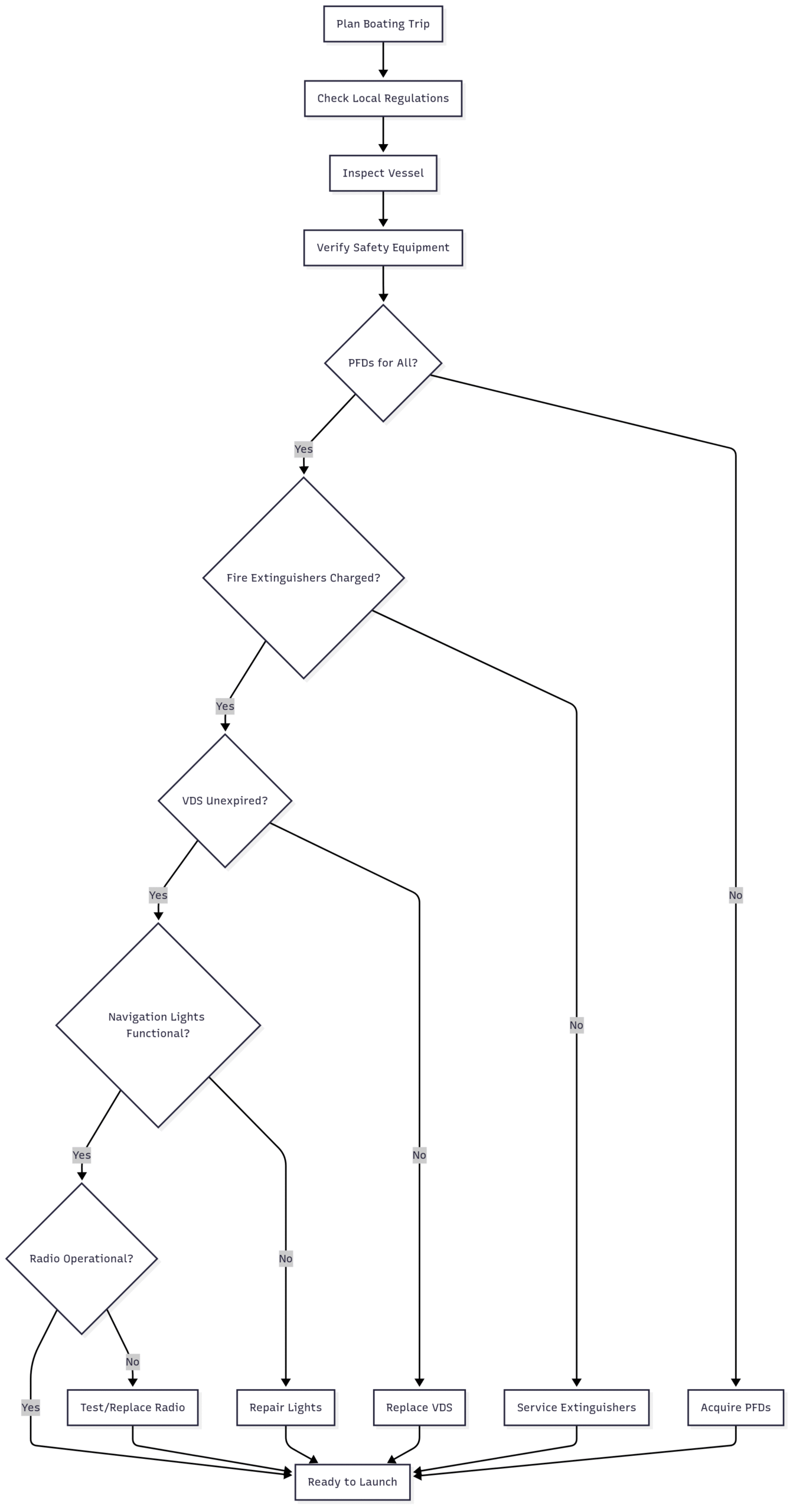
Budgeting for Safety Equipment
A basic safety setup for a small boat (<16 ft) can be assembled for $150–$300, including a few PFDs, a 5-B extinguisher, whistle, and distress flag. Larger boats (16–40 ft) may require $500–$1,000 for additional items like VDS, throwables, and VHF radios. Prioritize quality, USCG-approved gear to ensure reliability.
Final Thoughts
Equipping your boat with the right safety gear is a legal and moral responsibility. From life jackets to navigation lights, each item plays a critical role in preventing and managing emergencies. Combine this with a boating safety course to enhance your knowledge and confidence. Regular inspections, proper storage, and crew training ensure your equipment is ready when needed. Invest in quality, maintain diligently, and boat with peace of mind, knowing you’re prepared for any situation.
For further details, consult USCG guidelines or state resources like the Virginia DWR. Safe boating starts with preparation—equip your vessel and educate yourself to enjoy the water responsibly.
Share What Safety Equipment is Required on a Boat? with your friends and Leave a comment below with your thoughts.
Read The Ins and Outs of V-Drive Transmissions: A Extensive Guide until we meet in the next article.
